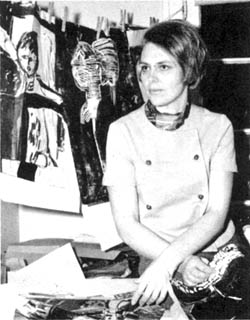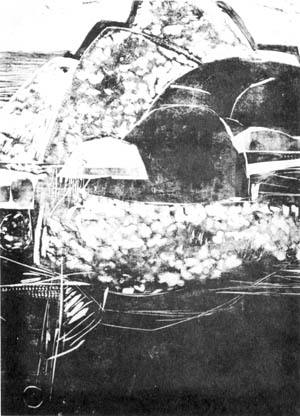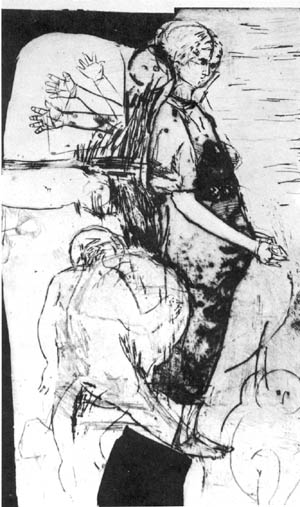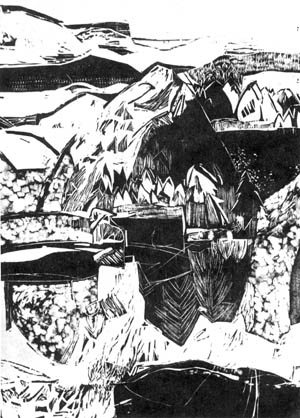Editors of this issue: Antanas Klimas, Thomas Remeikis

|
LITUANUS
LITHUANIAN QUARTERLY JOURNAL OF ARTS AND SCIENCES
Volume 19, No.1 - Spring 1973
Editors of this issue: Antanas Klimas, Thomas Remeikis Copyright © 1973 LITUANUS Foundation, Inc.
|

|
THE GRAPHIC ART OF NIJOLĖ VEDEGYS-PALUBINSKAS
 Nijolė Vedegys-Palubinskas' work has had numerous showings in the United States and Canada Cleveland, New York, and Chicago and Toronto, where she has had one-man shows. She has exhibited with the Ohio Graphic Artists, Ohio Artists, and the Cleveland Art Institute Alumni, of which she is a member. In addition to these shows, her work has been exhibited at the Cleveland Museum of Art, the American Greetings Corporation, Baldwin-Wallace College, and the
Massillon and Canton museums. Over the years she has won numerous awards. Nijolė Vedegys-Palubinskas is a member of the Artist Cooperative Gallery in Cleveland, where her work is on exhibit regularly.
Nijolė Vedegys-Palubinskas' work has had numerous showings in the United States and Canada Cleveland, New York, and Chicago and Toronto, where she has had one-man shows. She has exhibited with the Ohio Graphic Artists, Ohio Artists, and the Cleveland Art Institute Alumni, of which she is a member. In addition to these shows, her work has been exhibited at the Cleveland Museum of Art, the American Greetings Corporation, Baldwin-Wallace College, and the
Massillon and Canton museums. Over the years she has won numerous awards. Nijolė Vedegys-Palubinskas is a member of the Artist Cooperative Gallery in Cleveland, where her work is on exhibit regularly.
Adolfas Valeška has described her work as follows:
"The range of style and form in Nijolė Palubinskas' work is diverse in its technical execution. The subjects of her works are varied; however, when her study pieces are excluded, one becomes aware of her unique style. In each of her works, the objects depicted display her own personal vision. The key to Mrs. Palubinskas' creative character lies in the simplicity, the lucidity, and in the melancholically lyrical quality of her composition. Among Lithuanian graphic artists, Nijolė Palubinskas' works have their unique character, for they show a tendency to a greater freedom of form (they are more "painterly") than the works of her contemporaries, who tend toward ornamentalism. The predominant subject of her works is the landscape, a subject found infrequently in the works of Western graphic artists. Graphic technique is limited with respect to the subtle nuances that require expression in a landscape, and only an artist with an intimate understanding of nature, along with a rhythmical feeling for line and form, can solve this problem successfully.
'Leaving Day, Entering Night,' a multi-tonal woodcut, communicates to the viewer in the basic language of the artist the language through which she expresses her creative vision. In the first plane of this landscape we see four boulders placed horizontally, each individual form (silhouette) with different features colored by soft, gray tones. Above these boulders floats a horizontal streak, also gray, but of different texture. The streak is the element that binds together the individual forms of the rocks, thereby producing a pleasing, unified composition. Above the gray streak is a line of horizon on which rests a round form the setting sun. These few elements, balanced among each other rhythmically and tonally, comprise the total composition, which shows the artist's esthetic and compositional sophistication.
'Rocky shore,' an intaglio, displays expressive qualities: the masses of black and white forms are contrasted somewhat more architectonically, but the overall compositional theme is the dynamic relationship of forms.
"In Nijolė Vedegys - Palubinskas' graphic works, more so than in her works in other media, the technical execution is especially sensitive, for the technique itself is the medium through which the artist can express his ideas." (Draugas, suppl. [Science, Art, and Literature,] Sept. 23, 1972, p. 3.)
A. Z.

ROCKY SHORE

OUT OF REACH - Intaglio

CANADIAN LANDSCAPE Woodcut

COUPLE Intaglio